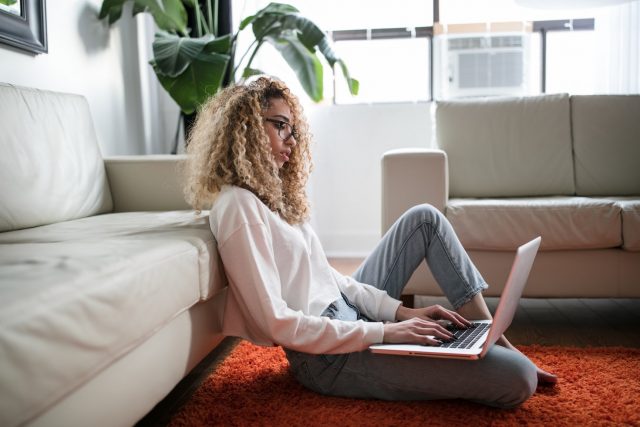Your home is where you should feel comfortable, safe, healthy, and secure. When you transition your home to facilitate work from home, or even study from home, however, you need to pay attention to function and ergonomic design. It can be hard to stay focused when working at home, and more than that, you are introducing stress into the space that you don’t deserve.

In an ideal world, you will be able to work in a home office and leave that stress behind in that room, but with small apartments, big families, and a variety of complications, this isn’t always the case. You need to take advantage of the space that you have and revamp the design so that your entire home feels more welcoming and energizing.
From the furniture you choose, to design dos that will help make it so much easier to work from home, study from home, or be productive at home, this guide will cover absolutely everything that you need to know.
How to Identify Space Opportunities in Your Home
If you have a spare room that you have already planned to convert into a home office, then excellent! You are on your way to redesigning your home with productivity in mind. If, on the other hand, you don’t have a clear or obvious location to set up a WFH or SFH area, there are a few tricks to help you identify them.
- Create a floorplan
A great way to visualize the space and to play around with the layout of your furniture is by creating a floor plan. You can easily do this online today or with a free tool. Simply measure your space and recreate it digitally. You will also want to measure the large furniture pieces in your room, like the dining table or couch so that you can then add your furniture into the space and play around with the layout without having to drag heavy furniture from spot to spot or room to room.
Creating a floorplan can also help you explore more creative options, for example, built-in storage or even the possibility of opening up walls if you have the budget. Since everything is digital, you can
- Use a Closet
A great way to add a desk and study area to your home without intruding on your existing living space is to use a closet. Add in a tabletop instead of a desk (you will need to screw in supporting beams underneath), and you can install your own custom desk into a closet. This does tend to get dark, however, so you will need plenty of lighting.
As blue-white light (in other words, daylight) actually helps us feel more productive and alert, you may want to consider daylight lights or lamps for this space. Play around with where you want the light to come from, as some have issues with overhead lights, and you don’t want your lamp to blind you.
Storage shelves should also be added so that you can store your work or study materials above you. Again, you only need a certain amount of headroom, and after that, everything can be additional storage opportunities. Don’t forget under your legs, either, especially as most of you will require a computer to work or study from home. If this computer is a desktop, ensure that there is space for it to sit comfortably underneath you, otherwise invest in a wire management solution and additional shelves or drawers to make your closet office as efficient as possible.
- Use Convertible Furniture
Convertible furniture is another excellent way to go. This is a great option is you don’t currently have an acceptable surface area or space to work in and are dealing with a small space, to begin with. A desk that can fold down, for example, can give you the perfect place to study or work from home productively. You can put the desk back up against the wall and have a bit more breathing room in your apartment when you are done.
Other convertible furniture should be considered as well. One of the most common types are those that also include storage. By increasing your storage options, you can keep your space clutter-free, which can help your mind stay focused.
- Transform Your Table
In the worst-case scenario, the final place that you can work or study from home effectively is right at your dining table. It is a good idea in this case, however, to invest in both comfort and efficiency upgrades for the space. This could be a mat, a specific chair, a second monitor, and so on. If you can easily pack it all up and reclaim your living space, you can mentally “turn off” at the end of the workday or study period.
Productivity-Boosting Additions to Consider
Having a desk and space for all the materials you need to work from home, or alternatively to study from home, is the bare minimum. You will also want to improve the energy of the space so that you feel focused and productive when you sit yourself down to get started with your day. A good routine is a great way to go about this, but to help you get started with as much success as possible, you will want to consider how you can introduce these productivity-boosting additions:
Light and Its Energy
Blue-white light, as stated, is the type of light that is found during the day. Our bodies are hardwired to respond to it, and it is for this reason that most, if not all, mobile phones coming out today have a night mode that dims the screen and tints it yellow. Unfortunately, while blue-white light can help make you feel more awake and alert, it can also disrupt your circadian rhythm.
This is our sleep rhythm, so not only do you need to pay attention to which lights you want to use when you want to be productive, you will want warmer lights for afterward when you want to tell your body that it is time to wind down.
Have a variety of light options keeps you in control and can help you harness the energy you need when you need it. For the sake of your home and the overall experience, you enjoy when in it, try to choose light design options that add to the beauty of your home. You can always customize the temperature of the light by using different bulbs.
Plants and Life
Plants and nature work to help boost our wellbeing and can help you stay relaxed and well. Green offices also work to improve productivity. Studies have even concluded that green or living office spaces can increase productivity by as much as 15% in comparison to lean, Spartan spaces that put an emphasis on minimizing distractions.
For best results, use real plants, but be aware that not every space can include them. For darker areas and for spaces not near windows, don’t be afraid to invest in high-quality fake plants for similar results.
Comfort and Textures
Your desk should be the right height for your body. The same applies to your chair. The furniture you choose should ideally look great, but more than that, it needs to be chosen for your body so that you can comfortably work in the space you have chosen for long periods. This doesn’t mean you shouldn’t get up, stretch, and get the blood flowing, but when you are sitting, you shouldn’t be worried about back pain or other discomforts from an improperly kitted-out home desk.
Sights and Engagement
Even if you work best with minimal distractions, it is always important to have visual stimuli. Staring at a screen can be very hard on the eyes, to the point where the muscles can become lax and can cause blurriness and eye strain. A good way to avoid this is to spend a short period looking away from a screen. Having interesting things to stare at nearby or even out a window, can help your eye adjust and minimize the eye strain associated with prolonged screen exposure.
You can break the monotony of your screen by creating, customizing, and printing out some fun, vibrant inspirational posters to put up on your wall and near your desk to keep your mood lifted.
Soundscapes
Music therapy is well established and is used to help people from many different walks of life with their various concerns and goals. Finding the right playlist, or building a playlist for yourself, can make a huge difference for your working or studying periods, especially if you time them to coincide with your “active” periods.
This means that done right, you can have a playlist that lasts for as long as you plan on working before a break. When the playlist ends, you can then take a moment away from your desk to refuel.
Combining planned breaks with music theory and soundscapes can help you be focused when you want to be and can help you get the most out of breaks by training your brain to work when you want.
How to Manage Stress Better Through Great Design
Stress is a silent killer. It worsens your mood, your immune system, your memory, and so much more. Working from home, or even studying from home after a long day at work, can make you more susceptible to stress. For those who work in high-demand careers, like as an MSN-APRN, the stress and demands from your day can be even worse.
Being able to manage your stress at home starts with great design. Having a beautiful, productive space to work in is a great way to get started, but you should also look at how you can improve the design of your home for comfort as well.
Nurses, for example, are now working highly stressful jobs in dangerous and understaffed locations. For those that are working towards their MSN or their DNP, it can feel like never-ending stress that doesn’t even get to stop when they come home.
Loving your job, or being fully committed to earning that next qualification, can help a lot when it comes to stress management. An APRN who is pushing through to earn their DNP so that they can start to use evidence-based practice more effectively because they believe in it is going to have a different experience from an RN who is honestly considering quitting their job and forgetting their MSN.
While having a productive, beautiful working space can help you stay focussed, it doesn’t actually help you stay relaxed. For that, you’ll need to use these tips to improve the rest of your home:
- Make it Easy to Put Away Clutter
Clutter and mess are two big stressors. Not only can they make you feel crowded and tense, but they can also actually be very distracting for those who are trying to work from home or study from home. Rather than just say you’ll clean it up and keep your space clean, make it easy for yourself by making it easy to hide clutter. From big baskets to hidden storage spots in furniture, there are many ways that you can easily hide clutter when you need to.
- Use Color Theory to Direct Your Mood
Use color theory to choose a color pallet that helps you direct your mood. For example, if you want to feel calmed and comforted, then blues and greens are great choices, and so too are neutrals. On the other hand, warm colors are perfect to feel cozy in as well, so though you cannot go wrong with a color choice, it is important to know what emotions you want to feel in your home and then work off those moods to decide your color pallet.
- Improve Your Air Quality
As the design is very personal, so other than tweaking your design to help you feel comfortable and at home, the only other tip that can universally work to improve your home’s space for relaxation is air quality control. You can buy an air purifier if you live in a city or improve the ventilation system in your home if the air outside is clean. Clean air helps boost our mood, helps us feel better, and can even help reduce issues like allergies; making is an excellent way to boost your space at home.

